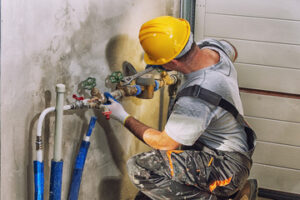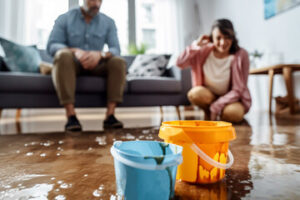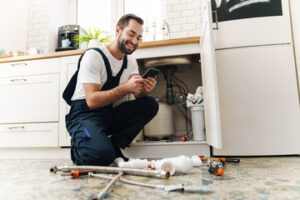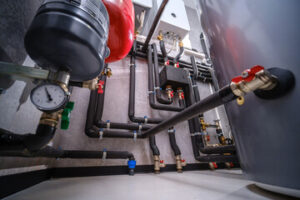Plumbers Clearwater FL are responsible for installing, repairing and maintaining the water and sewage systems that keep modern life running smoothly. They work in residential, commercial and industrial settings. They often collaborate with architects and construction teams to ensure plumbing systems are integrated seamlessly into building projects.

Many plumbers work on an emergency basis, so they are on call at all times and must be willing to travel to clients’ sites. They also frequently work evenings and weekends.
Plumbers are skilled professionals who can help with a variety of plumbing tasks. They can install new taps, fixtures and toilets, fix leaky pipes and repair clogged drains. They can also inspect and diagnose problems. They can work in homes, restaurants, hotels and other businesses. Some even handle septic systems and sewer connections. Plumbers are typically licensed and have years of experience. They also have the necessary tools and equipment to complete their jobs.
The cost of hiring a plumber can vary widely depending on the job and location. Many factors impact the plumber’s hourly rate, including experience, union dues, overhead, insurance, and parts and supplies. Some plumbers charge a flat emergency fee, while others charge by the hour. Plumbers may also be required to travel long distances to service customers, which can add to their costs. Some plumbers may also require a down payment before starting the work.
Some plumbing jobs are more complicated than others, and plumbers may need to use a wide range of tools. They also need to be able to read blueprints and understand construction codes. Plumbers often need to work in tight spaces and on ladders, so they must be physically fit. They must also be able to listen and communicate well with their customers.
In addition to their technical skills, plumbers must have a good grasp of mathematics and geometry. They must also be able to work in inclement weather. They are also required to follow local and national plumbing codes and regulations. Moreover, they need to have the ability to assess and solve problems quickly.
Another aspect of the job is the risk of infection. Plumbers must deal with human waste, which can contain dangerous microbes such as cholera, typhoid, hepatitis, and polio. Therefore, they must wear protective clothing and gloves when handling sewage pipes.
On average, a plumber earns between $45 and $150 per hour. However, this can vary greatly depending on the job, location, and other factors. Many plumbers charge higher rates during busy seasons, such as after heavy rains when water damage is common. In addition, some plumbers have additional fees for repairing septic systems and other complex jobs.
Hourly rate
If you need plumbing repair, it’s important to understand how much a plumber charges by the hour. This can help you plan for the costs of the work and make an informed decision when hiring a plumber. There are many factors that determine a plumber’s hourly rate, including the cost of materials and overhead. A plumber’s expertise level also plays a role in their price. For example, a highly skilled plumber will charge more than a beginner. The type of repair also affects the plumber’s rate. For instance, a simple fix like unclogging a drain is less costly than replacing a water heater.
Besides hourly rates, plumbers may also charge a service fee or minimum charge for a job. These fees are usually based on the type of repairs and the complexity of the work. A plumber will usually charge more for complicated jobs that require extensive testing, inspection, and repair. These services can include locating a hidden leak, installing new pipes, or replacing a water heater.
In addition to these charges, plumbers often add a markup to the cost of materials. This is to cover their expenses and make a profit. However, this markup varies from region to region.
Another factor that influences a plumber’s hourly rate is the amount of travel time to the home. Some plumbers charge an additional trip fee if they have to drive more than 10 miles from the shop. This fee can range from $50 to $300. In addition, a plumber might add a callout fee if you live outside of their normal working area.
In addition to the hourly rate, plumbers typically charge for their travel and equipment fees. Some plumbers have a flat rate for basic repairs, such as unclogging a drain or toilet. Others have a fixed price for more complex repairs, such as sewer line replacement or a bathroom remodel. Other fees can include disposal of hazardous materials and debris. If you want to save money, you can compare rates from several plumbers and choose the one with the best deal. You can even ask for a free quote from top-rated pros to get an idea of the costs before calling a plumber.
Emergency callout fee
When you have a plumbing emergency, you want to get help as soon as possible. However, it’s not always possible to find a plumber in your area that will offer an emergency callout service at short notice or at night. This is why it’s important to ask tradespeople about their call-out fees and hourly rates before hiring them. You should also ask whether there is a minimum charge and what services the call-out fee covers.
The cost of a plumber’s call-out fee varies from one business to the next. It depends on the type of work that needs to be done, and how long it will take to complete. The cost of the work itself will also affect the price, so you should ask a plumber for a quote before hiring them.
If the job is complicated, it will probably be more expensive than a straightforward repair. This is because the plumber will need to spend more time figuring out what’s wrong and finding a solution. For example, if the problem is a clogged drain or toilet, it might require special equipment to remove the blockage. These costs will add up quickly.
You should also consider the distance of the job. The farther away you live from the plumbing company, the more it will cost to travel there. This is because the plumber will have to pay for gas and mileage expenses. The distance may also increase if the job is on a steep or difficult site.
In addition to the call-out fee, you should also be aware of the plumber’s hourly rate. Some plumbers will charge a flat fee, while others will charge per hour. Some will even have a higher hourly rate for emergencies.
A good way to reduce the cost of an emergency call-out is to prevent problems before they occur. You can do this by performing preventative maintenance, like running a jug of hot water down your drains every month to keep them clear. Moreover, you should avoid putting food waste or oil down your kitchen drains. You should also avoid putting sanitary products or diapers down your toilets.
Materials
A plumber needs a variety of tools to work on plumbing problems. These tools include:
1. Adjustable pipe wrenches: These heavy tools help loosen and tighten the nuts and fittings on a pipework system. They come in several lengths, and a prepared plumber will carry a full set of them.
2. Plumbers’ tape: Also known as Teflon or PTFE tape, this is an essential tool for plumbers because it seals pipe threads to prevent leaks.
3. Leak detection tools: These are essential for identifying and locating leaks in pipes or fixtures.
4. A toolbox: A good quality toolbox is a must-have for plumbers to store their tools. A plumber should look for a toolbox with plenty of storage space and a handle that can be carried around.
5. Plumbers’ gloves: This is an important tool for protecting a plumber’s hands from cut hazards and staining from hazardous materials. Plumbers should wear gloves during all parts of the job, including cleaning up. Gloves will also help protect the plumber from slipping and falling, which is a common hazard on the job.
6. Screwdrivers: Having a tool kit that includes both flat and Phillips-head screwdrivers is useful for getting into hard-to-reach places, which plumbers will encounter often. It is also a good idea for a plumber to have stubby screwdrivers, which are a little longer than standard screwdrivers and allow for more control.
7. Pliers: Plumbers will use pliers to grab onto objects or cut materials. This is especially important for grabbing hold of small or narrow parts, such as those found in toilets and sinks. Plumbers should also have a pair of needle-nose pliers, which are used for gripping thin parts or tight spots.
8. Bolt and lock wrenches: These tools are helpful for removing stuck bolts, which can be difficult when they’re corroded or stripped.
9. Valves: Valves control the flow of liquids in a water system. They come in a wide range of types, including throttling valves, non-return valves, and isolation valves.
10. A torch: Plumbers need a torch to solder copper piping and other metal components. The torch also helps heat up plastic tubing to make it more flexible.








